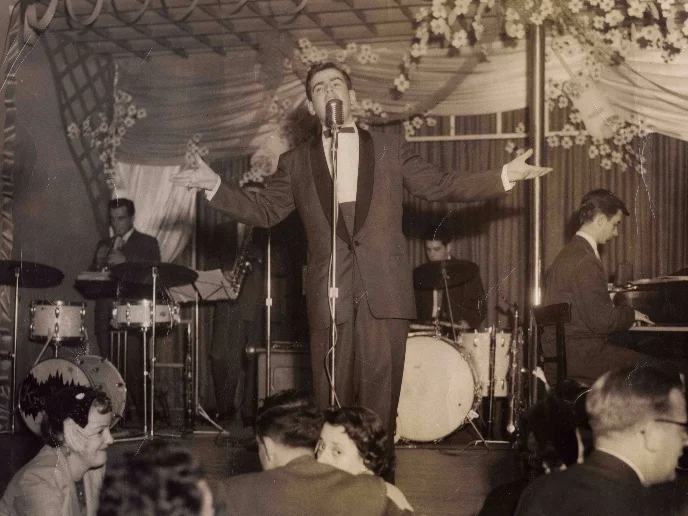Written by Gabrielle Houle
Clément Cantin (1933-2013), singer.
This photograph shows Québec singer Clément Cantin in performance. It comes from the personal collection of Nadia Cantin, Clément Cantin’s daughter. It is undated and the location of the performance is unknown. Given what we know about Clément Cantin’s artistic career, it is safe to assume that this photograph was taken during the early- or mid-1960s at one of Gérard Thibault’s cabarets in Québec City. Photo credits: Roussel.
Known on stage as Endré Clément, Clément Cantin livened Québec City’s nightlife through his performances as a singer and as a master of ceremonies during the late 1950s and the 1960s. It is unclear when, where, or how Cantin began singing professionally. According to an article published in Dis-Q-Ton, some time in 1961 or at the beginning of 1962, Cantin started “dividing his time between La Porte St-Jean, Chez Gérard, and Chez Émile.” All three were cabarets in Québec City and were owned by Gérard Thibault. The article continues:
Before this, he was applauded in a dozen other cabarets of Québec City and its surroundings, and at Château Deblois in Trois-Rivières. He also presented his singing act at Goose Bay in Labrador to entertain the American and Canadian troops that were stationed there. We have also seen André [sic] Clément on several television programs, including “La Boîte aux chansons.” (L. Cantin 27)
As a singer, Clément Cantin was known for his versatility and the possession of a “well-balanced voice, a great deal of personality, and a remarkable stage presence” (Ibid.). His repertoire comprised Canadian, French, and American songs that he liked. It included songs by Connie Francis, Billy Daniels, and Frank Sinatra, the last of whom was one of his favourite artists (L. Cantin; N. Cantin).
As a master of ceremonies, Clément Cantin would have had to expand his skills beyond music. The role would have obliged him to introduce guest artists to the public, entertain the audience in between acts, and sometimes participate in sketches with other performers. According to Gaston Boileau, who worked as a master of ceremonies at Chez Émile during the 1950s, the following would have been an emcee’s typical duties:
In the mid-1950s, the master of ceremonies facilitated the performance, sang three or four songs, told a few jokes, and then introduced the novelty act and the star. […] We generally changed the show every week unless it was a great success, as was the case with Ti-Gus and Ti-Mousse for example. The new programming started on Monday […] During the six years I worked [at Chez Émile], the place was always packed. (Qtd. in Thibault and Hébert 117)
A francophone, Clément Cantin also spoke English, something that would have helped him communicate (and mingle) with guest artists coming from the United States and from the rest of Canada to perform at one of Thibault’s venues. His linguistic abilities might also have been helpful when addressing English-speaking spectators from Québec City and American tourists.[1]
Cantin would have been within a minority among Québec residents who could understand both languages. According to data collected in the 1951 census, only 28.5% of francophones and 32.4% of anglophones aged 5 years and older in the province of Québec reported being able to speak both French and English; by 1971, these numbers were 27.6% and 38.9% respectively (“L’évolution du bilinguisme”).[2]
During his years as a performer at Chez Gérard, À La Porte St-Jean, and Chez Émile, Clément Cantin was approached twice by American scouts who offered him the opportunity to appear on The Ed Sullivan Show (N. Cantin). He declined both invitations. By the time he married in 1968, Clément Cantin had retired from the stage. What survives of his performance days are documents—including several photographs, handbills, personal letters, and music scores, many of which have been preserved by his daughter—and the memories of those who performed with him or heard him sing.
[1] According to data collected in the 1951 census, 8,006 of the 164,016 people living in Québec City at the time reported that English was their mother tongue (Dominion Bureau of Statistics Ninth Census 5). And of the 171,979 people residing in Québec City who participated in the 1961 census, 6,048 reported having English as their mother tongue (Dominion Bureau of Statistics Population 36).
[2] Between 1951 and 1971, the percentage of Canadians aged 5 years and older who reported speaking both French and English was much higher in Québec than in the rest of the country. In 1951, 7.5% of Canadians residing outside Québec declared they had the ability to speak both French and English. In 1961, the percentage raised to 7.6%, and in 1971, 8.5% of the Canadian population aged 5 years and older residing outside of Québec declared they had the ability to speak both languages (“L’évolution du bilinguisme”).
Works Cited:
Canada. Dominion Bureau of Statistics. Ninth Census of Canada 1951 – Population by official language and mother tongue. Ottawa: DBS, 1952.
Canada. Dominion Bureau of Statistics. 1961 Census of Canada -- Population: Mother Tongue, Counties and Subdivisions = Langue maternelle, comtés et subdivisions. Ottawa: DBS., 1970.
Cantin, Lucille. “Nos artistes de Québec.” Dis-Q-Ton, vol. 6, no. 12, p. 27, December 1962.
Cantin, Nadia. Personal phone conversation. August 2017.
“L’évolution du bilinguisme au Canada de 1901 à 2011.” Statistique Canada. www.statcan.ge.ca. Accessed on 18 September 2017.
Thibault, Gérard and Chantal Hébert. Chez Gérard: La petite scène des grandes vedettes. Les Éditions Spectaculaires Enrg, 1988.

